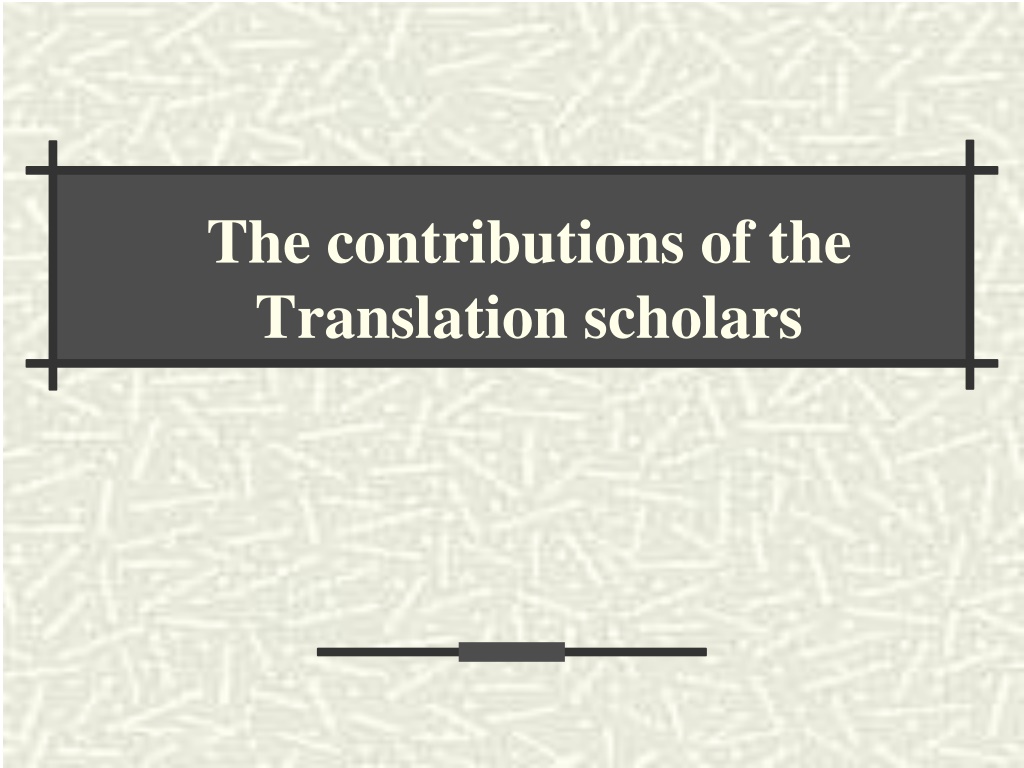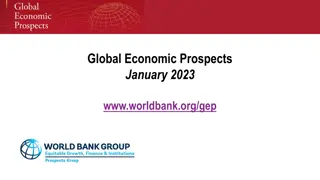
Contributions of Translation Scholars in Philosophy of Education
Explore the valuable insights of translation scholars like Nida, Fedorov, and Komissarov in the realm of education philosophy. Delve into their discussions on translation problems, logical relations of words, equivalence theories, and the significance of cultural and linguistic differences. Gain a deeper understanding of the pivotal role these scholars play in bridging language barriers and enhancing educational discourse.
Download Presentation

Please find below an Image/Link to download the presentation.
The content on the website is provided AS IS for your information and personal use only. It may not be sold, licensed, or shared on other websites without obtaining consent from the author. Download presentation by click this link. If you encounter any issues during the download, it is possible that the publisher has removed the file from their server.
E N D
Presentation Transcript
The Philosophy of Education The contributions of the Translation scholars
Nida His experience as a linguist and us a Bible- translator , In Nida, almost every translation problem is discussed . He adapts transformational grammar by proposing sentences as transitional stages between source and target language componential analysis diagnostic and supplementary components as tools for comparing and contrasting items within a semantic field. eight model kernel structures. by He common applies using ,
Nida He discusses the logical relations of words with each other , the difference between cultural and linguistic translation , the relevance of discourse analysis , the difficulties of translating between remote cultures levels of usage , the psychological connotations of words and practical problems of translation . His reduction of propositions to objects, events, relational and abstracts may be more fruitful to translators as a comprehension procedure than the kernel sentences. His distinction between dynamic and formal equivalence is too heavily weighted against the formal properties of language .
Nida Nida s Formal and Dynamic Equivalence 1.Formal equivalence seeks to reproduce SL surface structures as exactly as possible . 2.Dynamic equivalence focuses on evoking a similar response as in the source language . For example , Lamb of God ( symbolizing innocence ) was translated into seal of God for the Innuit (unfamiliar with lambs ) Give us this our daily bread .Here bread is rendered into fish or rice in cultures where these are stable food .
Fedorov Fedorov (1958. 3968) stresses that translation theory is an independent linguistic discipline , deriving from observations and providing the basis for practice. Like the Leipzig School , he believes that all experience is translatable , and rejects the view that language expresses a peculiar mental word -picture . However , the lack of a common outlook or ideology at present impairs the effectiveness of translation.
Komissarov Komissarov moving in three directions : the denotative (information translation ), the semantic ( precise equivalence) and the transposition of relevant structures). His theory of equivalence distinguishes five levels: (1) lexical units , (2) collocations , (3) information, (4) the situation , and ( 5 ) the communication aim . (1973) sees translation theory transformational (
Leipzig School The Leipzig School ( Neubert , Kade , Wotjak , Jiiger , Helbig , Ruzicka)distinguishes sharply between the invariant (cognitive ) and the variant (pragmatic) elements in translation , and turns transformational grammar account . It is sometimes short on procedures and examples , and restricts itself to non - literary texts . Neubert s and Helbig's writing has been imaginative. and semiotics to
Koller,Reiss,Catford Koller (1972) is particularly useful in distinguishing information from communication , and Reiss ( 1971) has categorized and illustrated the variety of text - types. Catford (1965) has applied Halliday's systemic grammar to translation theory , and has fruitfully categorized translation shifts between levels , structures, word-classes, units ( Rank-shifts' ) and systems . He distinguishes between context (of situation ) and co-text (of language ) . He sets greater limits to the possibilities of translation than other theorists.
Firth ,Mounin Firth ( 1968) points to contextual meaning as the basis of a translation theory and sees translation theory as the basis of a new' theory of language and firmer philosophy , Mounin (1955, 1964, 1967) discusses translation theories and their relation to semantics and supports the linguistic against the literary theory of translation . foundations in
Levy ( 1969) and Winter (1969) apply linguistics to the translation of literary texts , including the phonological aspects of poetry , Wuthenow (1969) , Kloepfer (1967) and Cary (1956) reject all but a literary approach to translation theory .
Vinay and Darbelnet Vinay and Darbelnet (1976) are outstanding . They enumerate seven transliteration , loan translation , literal translation , transposition , modulation , equivalence , adaptation and perceptive distinctions between French and English procedures- make
Steiner Steiner (1975) contains a variety of outstanding literary translation and summaries of translation theories, and emphasizes translation as a key to the understanding of thought , meaning, language , comparative linguistics. He puts the case for poem to poem against plain prose translations (1966). the importance of communication and
Equivalent-effect principle The emphasis of this principle is rightly on communication , on the third term in the translation relationship , on the reader ( Who is the reader ? is the translation teacher s first question) , who had been ignored previously translation. The translator should produce a different type of translation of the same text for a different type of audience. The principle emphasizes the importance of the psychological factor it is mentalistic its success can hardly be verified . , except in Bible
Equivalent-effect principle First, non -literary text describes, qualifies or makes use of a peculiarity of the language it is written in , the reader of the translation will have to have it explained to him , unless it is so trivial that it can be omitted.
Equivalent-effect principle Secondly, a non-literary text relating to an aspect of the culture familiar to the first reader but not to the target language reader is unlikely to produce particularly , if originally intended only for the first reader . The translator , therefore, say , in translating the laws of a source -language country , cannot bend' the text towards the second reader . equivalent effect:
Equivalent-effect principle Thirdly , there is the artistic work with a strong local flavour which may also be rooted in a particular historical period . The themes will consist of comments on human character and behaviour universal , applicable to the reader of the translation , and therefore subject to the equivalent - effect principle . On the other hand , the work may describe a culture remote from the second reader 's experience, which the translator wants to introduce to him not as the original reader , who took or takes it for granted , but as something strange with its own special interest . Wine-dark sea (Sky) blue sea
Equivalent-effect principle in Benjamin's words , No poem is written for its reader , nor is regard for those who receive a work of art useful for the purpose of understanding it ( 1923) ) , then the equivalent -effect principle is irrelevant in the translation of a work of art : the translator s loyalty is to the artist , and he must concentrate on recreating as much of the work as he can .
Equivalent-effect principle The priorities differ for each work , but there are three rules of thumb: (a ) the translation should be as literal as possible and as free as is necessary. (b) a source language word should not normally be translated into a target language word which has another primary one-to-one equivalent in the source language. ( c ) a translation is impermeable to interference it never takes over a typical source language collocation , structure or word -order.
Equivalent-effect principle These rules apply to literal' as to the much more common equivalent-effect translation. plausible , is always mistranslation. Interference, however Paradoxically , the literal ' principle of translating works of art is scientific and verifiable , whilst the equivalent - effect principle is intuitive .
Other methods of translation There are also other restricted methods of translation : information translation , ranging from brief abstracts through summaries to complete reproduction of content without form; plain prose translation to guide one to the original , whose language should always be a little familiar; interlinear translation , which shows the mechanics of the original : formal translation , for nonsense poetry and nursery rhymes, where the meaning and the scenario , but not the tone , can be ignored ;
Steiner academic translation , for converting a text to a standard literary style ; a combination of transliteration , translation and paraphrase for texts concerned with the source language , where the metalingual (Jakobson , 1960) function predominates .
To conclude Translation theory , however , is not concerned with restricted translation . Whilst principles have been , and will be , proposed for dealing with recurrent problems ( translation rules ) , a general theory cannot propose a single method fe . g. dynamic equivalence), but must be concerned with the full range of text - types and their corresponding translation criteria , as well as the major variables involved .











